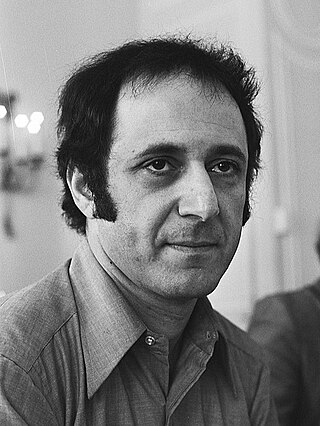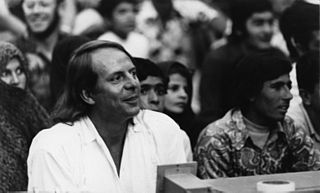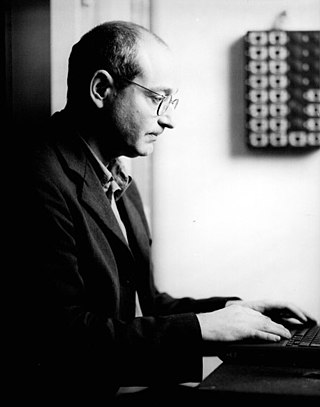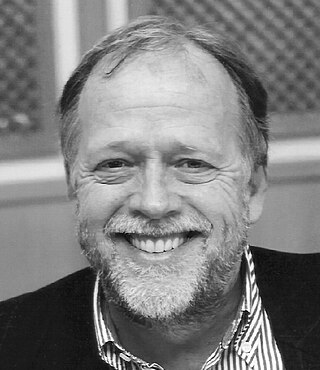Related Research Articles

Stephen Michael Reich is an American composer who is known for his contribution to the development of minimal music in the mid to late 1960s. Reich's work is marked by its use of repetitive figures, slow harmonic rhythm, and canons. Reich describes this concept in his essay, "Music as a Gradual Process", by stating, "I am interested in perceptible processes. I want to be able to hear the process happening throughout the sounding music." To do so, his music employs the technique of phase shifting, in which a phrase is slightly altered over time, in a flow that is clearly perceptible to the listener.

John Stanley Body was a New Zealand composer, ethnomusicologist, photographer, teacher, and arts producer. As a composer, his work comprised concert music, music theatre, electronic music, music for film and dance, and audio-visual gallery installations. A deep and long-standing interest in the music of non-Western cultures – particularly South-East Asian – influenced much of his composing work, particularly his technique of transcribing field recordings. As an organiser of musical events and projects, Body had a significant impact on the promotion of Asian music in New Zealand, as well as the promotion of New Zealand music within the country and abroad.
Carlos Sandoval Mendoza is a Mexican/German freelance composer and multimedia artist mostly recognized for his work joining technology and a Gestalt approach to the art of music composition and performance. Michael Zwenzner describes him as a "Socio-critical magician of the extended-multimedia instrumental theater"

Karlheinz Essl is an Austrian composer, performer, sound artist, improviser, and composition teacher.
Hans Tutschku is a German composer.

Aus den sieben Tagen is a collection of 15 text compositions by Karlheinz Stockhausen, composed in May 1968, in reaction to a personal crisis, and characterized as "Intuitive music"—music produced primarily from the intuition rather than the intellect of the performer(s). It is Work Number 26 in the composer's catalog of works.

Georg Hajdu is a German composer of Hungarian descent. His work is dedicated to the combination of music, science and computer technology. He is noted for his opera Der Sprung – Beschreibung einer Oper and the network music performance environment Quintet.net.
Åke Parmerud is a Swedish composer, musician, and multimedia artist noted for his acoustic and electronic works, which have been performed mostly in Europe, Mexico, and Canada. He is also noted for the design of stage and acoustics as well as interactive media and software. He has received recognition for his work from a number of festivals in Europe and has won two Swedish Grammis awards. He has been a member of the Royal Swedish Academy of Music since 1998.
Oliver Martin Schneller is a German composer and saxophonist.

Michael Obst is a German composer and pianist.

Bruno Liberda is an Austrian composer of contemporary classical music.
Eres Holz, is a German composer of Israeli origin. He has been living in Germany since 2003.

Iris ter Schiphorst is a German composer and musician.
Simon Steen-Andersen is a Danish composer, performer, director and media artist.

Für kommende Zeiten is a collection of seventeen text compositions by Karlheinz Stockhausen, composed between August 1968 and July 1970. It is a successor to the similar collection titled Aus den sieben Tagen, written in 1968. These compositions are characterized as "Intuitive music"—music produced primarily from the intuition rather than the intellect of the performer(s). It is work number 33 in Stockhausen's catalog of works, and the collection is dedicated to the composer's son Markus.
Stefan Prins is a Belgian composer and performer.

Musik für ein Haus is a group-composition project devised by Karlheinz Stockhausen for the 1968 Darmstädter Ferienkurse. Fourteen composers and twelve instrumentalists participated, with the resulting performance lasting four hours. It was not regarded by Stockhausen as a composition belonging solely to himself, and therefore was not assigned a number in his catalog of works.
Alexander Schubert is a German composer. Much of his music is experimental, involving multimedia, improvisatory, and interactive elements. He draws upon free jazz, techno, and pop styles.

Johannes Kreidler is a German composer, performer, conceptual and media artist. He is the principal theorist and exponent of the New Conceptualism movement in 21st-century music.
Thomas Christoph Heyde is a German composer, media artist and curator. He is chairman of the Forum Zeitgenössischer Musik Leipzig.
References
- ↑ "Kulturstiftung Schloss Wiepersdorf - Schloss Wiepersdorf (en). www.schloss-wiepersdorf.de" . Retrieved 10 May 2023.
- ↑ "Musikautor innenpreis" . Retrieved 10 May 2023.
- 1 2 "Like in a hamster wheel – Interview with Michael Beil – Youtube". YouTube . 17 March 2014. Retrieved 10 May 2023.
- ↑ Beil, Michael (2012). "Material Shift". Musical Material Today. Hofheim: Wolke. p. 9-20.
- ↑ "Michael Beil on Mach Sieben" . Retrieved 10 May 2023.
- ↑ "Lemma Michael Beil in Die Musik in Geschichte und Gegewart" . Retrieved 10 May 2023.
- ↑ Dhooghe, Yarrid (14 January 2017). "Program notes Nadar Ensemble WYSI(N)WYG in De Singel, Antwerp" (PDF). Retrieved 10 May 2023.
- ↑ Diependaele, Rebecca (29 March 2018). Program notes Nadar Ensemble Doppelgänger Deluxe in Concertgebouw, Brugge (29 March 2018).
- ↑ Diependaele, Rebecca (11 March 2018). Program notes Nadar Ensemble Homejacking in Concertgebouw, Brugge (11 March 2018).
- ↑ P. Gielen and T.R. Moore (2023). Hide to Show: Memefying Live Music, Algorythmizing Social Relationships. ISBN 9789464755497.
- ↑ Diependaele, Rebecca (10 November 2021). "Program notes Nadar Ensemble Hide To Show in De Singel, Antwerp" (PDF). Retrieved 10 May 2023.